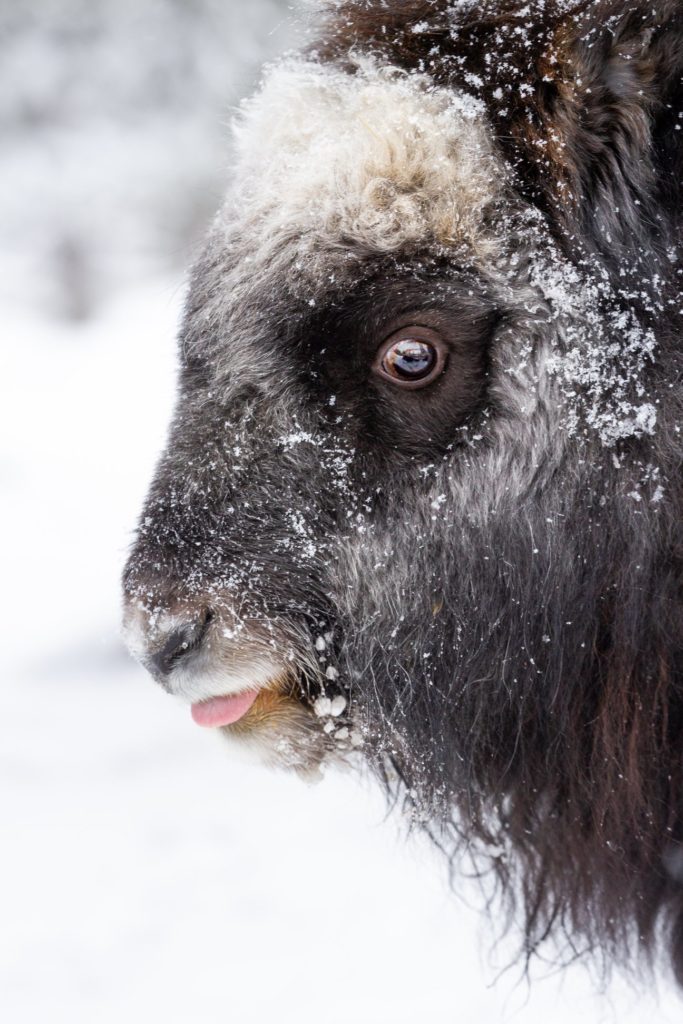The Chinese Zodiac year of the Ox has begun. Oxen tend to be recognized for their contributions to animal agriculture and are treated as commodities rather than sentient beings. Oxen are beautiful and important creatures who deserve much more credit than they receive. The muskox is one of the most underrated members of the bovine family.

What are musk oxen?
Muskoxen (or Ovibos moschatus) are bovine native to the arctic tundra. Muskoxen are much larger than their cousin, the cow. On average, muskoxen are about five feet tall (1.5 meters) tall and weigh between 500–800 (273–364 kilograms) pounds. They live between 12-20 years in the wild. During the winter, the muskoxen use their hooves and horns to dig through the frozen tundra to graze on grasses. In the warmer months, the muskox eat grasses, leafy plants, mosses, herbs, and shrubs.
Where is the muskox?
The muskox is one of the last prehistoric animals existing today. Fossil evidence suggests that the muskox lived among mammals and the woolly rhinoceros in Scandinavia between 30,000–44,000 years ago. There are two theories as to why the muskox left Scandinavia:
- The climate gradually got warmer and the muskox were forced to migrate farther North.
- The hunting of the muskox may have led to their extinction in Scandinavia.
The muskox could only be found in Northern Greenland and along the icy coast of Canada during the early 1900s. There were several failed attempts to reintroduce the muskox to Scandinavia. Twenty muskox calves were transported to Scandinavia after World War II, and only eleven survived the journey. Fortunately, their descendants still live in Norway today. A herd of their descendants wandered into Sweden in 1971. They live in the Härjedalen mountains, but their population began to decrease. However, over the last 20 years, there have been many effective attempts to improve their genetic diversity, population, and conditions.
Today, the muskox exists in Greenland, the Canadian Arctic, Alaska, Norway, Sweden, and Siberia.

How is climate change affecting the muskox?
Due to climate change in the arctic, the muskoxen’s population in Canada has dropped by 80%, as of 2019. Global warming has caused parasites to expand their range in the muskoxen’s environment, compromising much of their food sources. Global warming is also causing more winter rain. When subzero temperatures return, the freezing rain can soak the muskoxen’s base layer of fur, causing the muskox to die due to an inability to retain body heat. If they survive, the freezing temperatures can create a new layer of ice, preventing muskoxen from accessing critical food sources.
As stated by the University of Calgary veterinarian and doctoral student, Dr. Juliette De Francesco, “Muskoxen are a unique species that have lived in the Arctic for thousands of years, surviving the last ice age…they’re critically important in the north culturally, ecologically and economically, and need to be conserved.”

How can I help the muskox?
- Myskoxcentrum is a Swedish muskox conservationist organisation. They have been helping save and preserve the muskox population of Sweden. Here is more information about their organization.
- Adopting a muskox can help the Alaska Wildlife Conservation Centre preserve muskoxen.
- You can talk to the people around you or make posts on social media, raising awareness to the importance of muskox preservation.
Here’s an informative short film on the muskox.
Get more like this—Sign up for our daily inspirational newsletter for exclusive content!
___
Photo: Myskoxcentrum i Härjedalen, via Facebook




